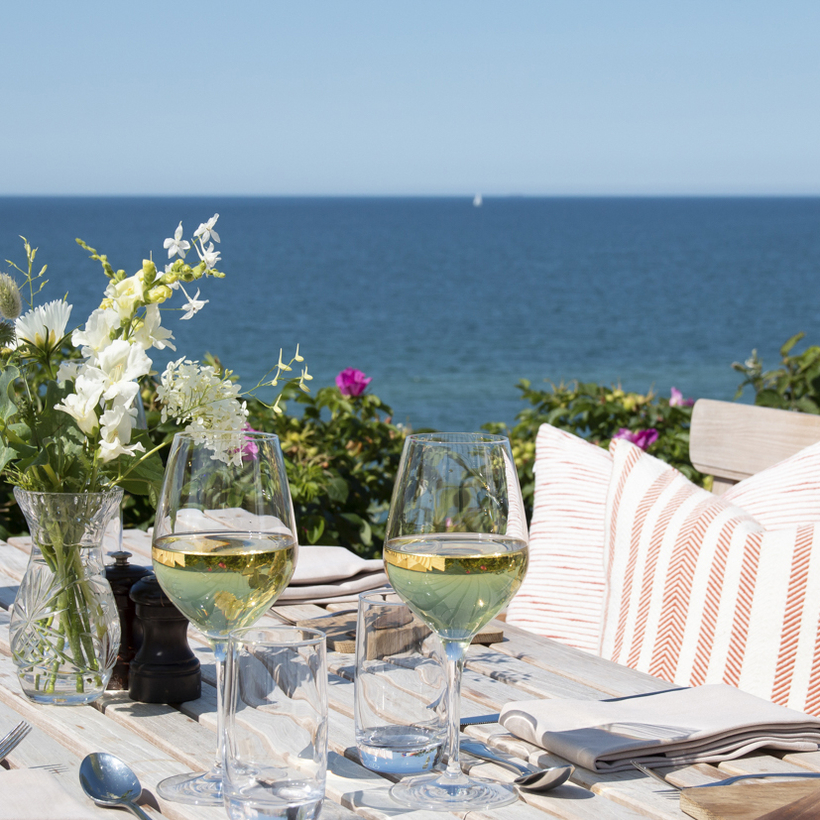On a Sunday evening in late June, the Danish beach town of Tisvilde was winding down after a busy weekend. At the small blue shack that houses Hansens Ice Cream Parlour, families were securing their last scoops of organic vanilla. Tanned teens with sandy toes and cat-eye sunglasses trailed up the sidewalk back into town. Quaint, relaxed, and charmingly windswept, Tisvilde has been drawing Copenhagen’s creative class for decades. It is reminiscent of what the East End of Long Island was like in the 70s, before the billionaires arrived and high-end fashion boutiques transformed its picturesque main streets into Bergdorf-sur-Mer.
But that may be about to change. Tisvilde and its neighboring towns on what is known as the Danish Riviera are already showing signs of boom times courtesy of Ozempic, of all things. In the past two years, Novo Nordisk, the manufacturer of the weight-loss drug (as well as half the world’s insulin supply), has transformed Denmark’s economy, boosting its G.D.P. by 1.8 percent in 2023.

With its manufacturing plant in the nearby town of Kalundborg, it has not only enriched its employees—C.E.O. Lars Fruergaard Jørgensen earned $9.9 million last year, the nation’s second-highest salary among publicly traded companies—but it also recently made an $8.6 billion investment in Kalundborg’s facilities and services for its 4,500 employees, who comprise a quarter of the town’s population. (The company also plans to add another 1,250 jobs.)
Novo Nordisk’s success has been good for business in all sorts of ways, from selling more smørrebrøds (open-faced sandwiches) to fueling the housing market. (According to Bloomberg, Denmark’s low interest rates are caused by a strong krone fueled by the pharmaceutical industry.)
This will inevitably trickle down to Tisvilde, an easy, hour-long drive from Copenhagen that has drawn the city’s creative class for decades. (There are no Alec Baldwin types—yet—but you might bump into Jeremy Strong, who owns a house in town.)
Instead of oceanfront mansions, Tisvilde is known for its low-slung wooden cabins filled with midcentury furniture and heirloom Louis Poulsen lights. Its residents’ unofficial uniform relies on organic-cotton shorts and oversize shirts from the Danish brand Tekla, ideally taken out for a drive in a buttercream, 70s-era Mercedes-Benz.

Helenekilde Badehotel, Tisvilde’s best hotel, is set in a stark white building and overlooks the ocean. It has been hosting vacationers since 1904, and although it has experienced several changes in ownership—most recently the Kølpin family, who are behind the Hotel Sanders, in Copenhagen—the DNA hasn’t changed. The rooms are quintessentially Danish and unfussy, with powdery green walls, white wooden headboards, and simple linens. There are ample lounges and reading nooks and overstuffed couches and rattan chairs, as well as a sprawling, sun-drenched terrace. Dinner is simple—grilled fish and seasonal greens—but that’s exactly how the locals like it. And even in peak season, rooms go for around $400 per night.
In town, the main street has recently had a glow-up; its stores now sell Dior sunglasses, raffia beach bags, and Goop-y sunscreen. Bobben, a shop from the founder of the Rudolph Care beauty brand, is set in a small wooden cabin that resembles a beach hut and stocks beaded jewelry from MA | RE Gold and striped cotton pants and dresses from Proem Parades.
In the evenings, the only place to be is on the terrace at Tisvilde Kro, a brasserie set in an old pink building that looks like it belongs in a Roald Dahl book. The restaurant was purchased a few years ago by the founder of the travel site Momondo, and its freshened-up menu includes seasonal asparagus, freshly caught monkfish, and shrimp.
Just outside town, Rabarbergaarden (the Rhubarb Farm) is an environmentally minded farm and restaurant founded by former Copenhageners Louise and Thomas Køster. Its sunny garden, where sheep can be heard bleating in the background, is the perfect spot for Sunday lunch followed by shopping for sourdough and honey in the farm store.
With Tisvilde as a home base, the region offers plenty of opportunities to explore. Drive west to discover Lynaes Surfcenter and Madbar, a community surf hub and restaurant started by Jeppe and Johan Ingversen, two young brothers who grew up in town. Order a pizza overlooking the yacht-filled harbor, take a paddleboard out into the waves, or shop for swimshorts from Swedish brand OAS.

Further south and inland, more good food awaits. Outside Hillerød, the Mangholm regenerative farm rents delightful cabins that spill onto a wild lawn. On weekends, its restaurant opens for lunch and dinner and serves small plates such as beets with coriander seeds and traditional Danish custard cake. The produce is so good that chefs from Noma are known to lend a hand in the garden; another three-Michelin-starred restaurant, Geranium, has hosted pop-ups here as well.
Those seeking some culture will enjoy nearby Frederiksborg Castle, a towering complex of ancient structures built for the Danish king in the 17th century. It’s tempting to get lost in its labyrinth of stately rooms, which are piled high with ancient furniture and paintings. Because this is Denmark, there’s also an excellent restaurant run by Rabarbergaarden, so stay for pickled herring on rye.

Travel east to the Rudolph Tegners Museum & Statuepark, where masterpieces from the Danish sculptor dot a hilly landscape. From there, it’s a short drive to the Louisiana Museum of Modern Art, arguably Denmark’s best-known cultural institution, located majestically on the ocean. Its works by Alberto Giacometti and Yayoi Kusama are as alluring as its excellent gift shop.
Roughly 30 minutes on the highway will deposit city-oriented visitors back in Copenhagen, but it’s more tempting to return to Tisvilde for an early-evening dip. Don’t be afraid to head straight to dinner in a bathing suit and cover-up—this might be the Danish Riviera’s ritziest town, but there’s no need to break out the Manolo Blahniks. At least for the time being.
Mary Holland is a New York–based writer who contributes to the Financial Times, The Wall Street Journal, and Monocle

